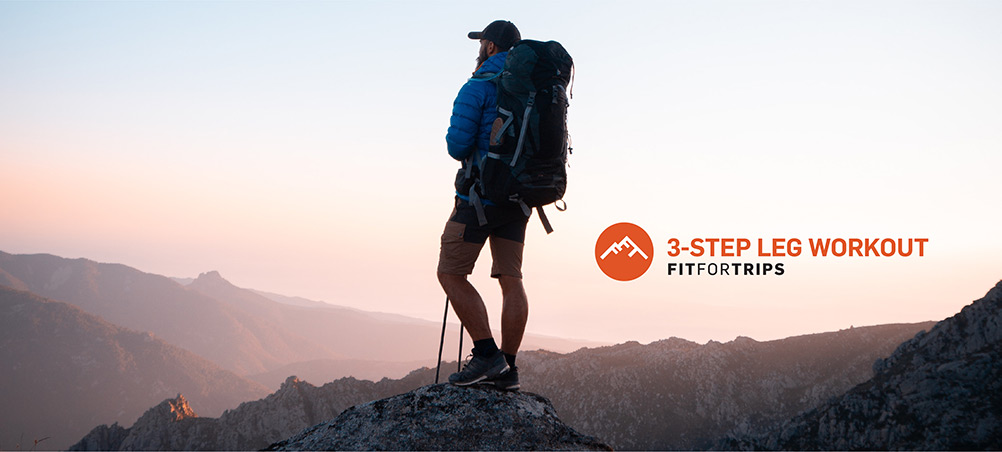Hiking Training Plan Leg Workout Made Simple: 3 Step Workout Plan

Sometimes, simple exercises aren’t always effective when you’re training for mountain hiking; that’s why I’ve developed a hiking training plan leg workout you can easily do at home that will get you the results you need.
This plan is designed to plug right into your current training regimen twice a week to help supply strength and power for your hike. You should also complement this training plan with endurance training. For endurance gains, you should plan on hiking for several hours on the weekend and perform some general training throughout the week.
A training plan to get your legs in shape that’s safe, effective, and simple is incredibly important when you’re preparing for mountain hiking. This is especially true if you don’t hire someone to craft a training program for you, or you aren’t an expert at putting together your own training program.
Why a hiking training plan leg workout is critical
Think of your legs as the wheels that carry you up and down the trails. In order for wheels to move, they need strength and power to push them along. That’s why the key factors to ensuring your legs are up to the task of a mountain hike are just the same as wheels: you need strength and power to keep your legs moving.
Simply put, by performing these exercises twice a week, as well as hiking for several hours on the weekend and getting in some general training during the weekdays, you should be in great condition for rolling hills as well as steep ascending and descending hikes.

What happens if you don’t train your legs before a hike?
Here’s the short answer: If you go into a mountain hike without power in your legs and the endurance to keep them moving, you are guaranteed to have a bad time.
- You won’t be able to tolerate the steep or even moderate ascents for very long.
- You’ll be incredibly sore after your hike and run into trouble day 2 if you’re on a multi-day hike.
- You’ll have less durability and be more prone to injuries like muscle strains, as well as falling from lack of stability and surefootedness.
Rules for Your Hiking Training Plan Leg Workout
Step 1. Choose one of the following as a warmup:
- Go on a walk or hike that takes longer than 40 minutes.
- Spend 20+ minutes on any cardio machine at a moderate or high intensity.
Step 2. Perform the following exercises in sequence:
- Body Weight Squats
- Wide Leg Forward Fold
- Low Lunge Stretch
- Bridge Pose
- Side Lunge *Skip this exercise if you feel knee pain or discomfort during this movement.
- Repeat each exercise 1 to 2 times.
- Do 10-15 reps each and hold any stretch positions for several deep breaths.
Step 3. Perform 3 lower body exercises from the list below in sequence, starting with the one that is “moderately hard.”
Here’s an example of a sequence:
If the 2. Modified Reverse Lunge is “easy” and the 3. Walking Lunge is “moderately hard,” then begin with the 3. Walking Lunge, move to the 4. Split Squat, and then finish with the 5. Reverse Slide Lunge.
*You can add a fourth exercise in the sequence if you want to train more aggressively for steeper ascents.
Lower Body Exercise List
Equipment needed:
- Valslides (These come with a booklet to help you explore other exercises, as well).
- Any set of Adjustable Dumbbells (for intermediate to advanced).
- These replace 8 pairs of dumbbells to save space. Their weight can be adjusted in seconds from 3 pounds up to 24 pounds each. While you can use regular dumbbells as well, these space saving ones are amazing for the home.
- Assisted Lunge (once you master this you will likely never perform again)
- Modified Reverse Lunge (once you master this you will no longer need the pad)
- Walking Lunge
- Split Squat
- Reverse Slide Lunge (you’ll need to use something like Valslide discs)
- Forward Lunge
- Alternating Forward Reverse Lunge
- Skip Lunge
- Reverse Lunge Hop
- Alternating Forward Reverse Lunge Hop
Rules for Step 3:
- Perform 2-3 sets for each exercise.
- Perform 10-12 repetitions per leg.
- Rest one minute between each set or perform some stretches from Step 2.
- Do not hold weight for your first round thru all exercises. You will add weight after you complete A-J, which could take several weeks or months.
- If you are performing exercises 9 (Reverse Lunge Hop) and 10 (Alternating Forward Reverse Lunge Hop), circle back to exercise 2 (Modified Reverse Lunge) as your 3rd exercise [skip 1 (Assisted Lunge) on your second round]. Add weight by holding adjustable dumbbells for exercise 2 (Modified Reverse Lunge).
- If you hold dumbbells in your hands, start with 3-5 pounds in each hand and increase weight in the lowest increments until the sets feel moderate to hard.
Are you planning a multi-day mountain hike and would like help getting in shape? Schedule a chat with Fit For Trips founder Marcus Shapiro to discuss any training concerns or questions regarding your next excursion.
*Consult with your physician or physical therapist if you have foot, ankle, knee, hip, or back problems before doing these exercises, especially the ones that have you jumping.

Pingback:How Kilimanjaro Training Program Help in High Altitude Hiking? – Site Title
Pingback:Get Fit At Home For your Next Trip! | Adventures Within Reach Travel Blog